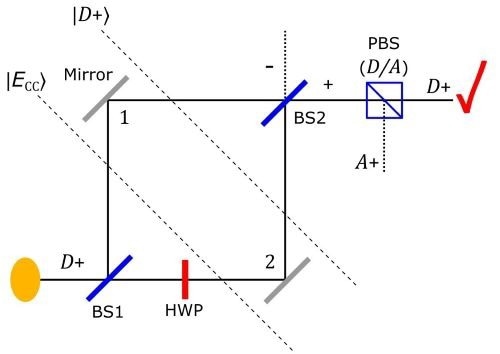The quantum Cheshire Cat effect is named after the fictitious Cheshire Cat from the novel Alice in Wonderland. That cat was able to vanish, leaving just its smile. Similarly, researchers stated in a 2013 publication that quantum particles may dissociate from their attributes, with the qualities traveling along pathways the particle cannot. This came to be known as the quantum Cheshire cat effect.
 Interferometer used in quantum Cheshire cat scenario The simple interferometer used in the quantum Cheshire cat scenario, where a photon is prepared in the path-polarization entangled state |ECC〉, but is only considered if it arrives on output path + with polarization D. The paradox arises when we consider the photon’s path, polarization, and path-polarization correlation, while it is inside the interferometer. Image Credit: Jonte R. Hance/Hiroshima University
Interferometer used in quantum Cheshire cat scenario The simple interferometer used in the quantum Cheshire cat scenario, where a photon is prepared in the path-polarization entangled state |ECC〉, but is only considered if it arrives on output path + with polarization D. The paradox arises when we consider the photon’s path, polarization, and path-polarization correlation, while it is inside the interferometer. Image Credit: Jonte R. Hance/Hiroshima University
Since then, researchers have claimed to have gone much farther, switching disembodied attributes across particles, disembodying many properties at the same time, and even “separating the wave-particle duality” of a particle.
However, a new study published in the New Journal of Physics on November 17th, 2023, demonstrates that these tests do not truly reveal particles separating from their attributes but rather another perplexing property of quantum physics – contextuality.
The study of the behavior of light and matter at the atomic and subatomic scales is known as quantum mechanics. Quantum mechanics is, by definition, paradoxical. The study team went out to comprehend this paradoxical nature while also investigating practical benefits.
Most people know that quantum mechanics is weird, but identifying what causes this weirdness is still an active area of research. It has been slowly formalized into a notion called contextuality — that quantum systems change depending on what measurements you do on them.
Jonte Hance, Research Fellow, Hiroshima University
A quantum system can provide distinct outcomes from a series of observations depending on the order in which measurements are performed. For example, measuring a particle’s location first, then its speed yields different results from detecting the particle's speed first, then its location. Quantum systems can be measured as possessing qualities that we would anticipate to be mutually incompatible due to this contextuality.
Hance added, “However, we still don’t really understand what causes this, so this is what we wanted to investigate, using the paradoxical quantum Cheshire cat scenario as a testbed.”
The group points out that the issue with the quantum Cheshire cat paradox is that its initial assertion—that the particle and its attributes, such as spin or polarization, split apart and follow distinct trajectories—may not accurately reflect the physics at play.
We want to correct this by showing that different results are obtained if a quantum system is measured in different ways, and that the original interpretation of the quantum Cheshire cat only comes about if you combine the results of these different measurements in a very specific way, and ignore this measurement-related change.
Holger Hofmann, Professor, Graduate School of Advanced Science and Engineering, Hiroshima University
The group examined the relationship between three distinct measurements of a photon’s path and polarization inside the quantum Cheshire cat protocol to assess the Cheshire cat protocol. In the absence of background for the system, this would have appeared to be a logical contradiction. The study addresses the coherence between prohibited states and how this contextual behavior relates to weak values.
By their study, they demonstrated that the quantum Cheshire cat, which is usually encountered in pre- and post-selected systems, does not exhibit a property of the particle being disembodied, but rather exhibits the impact of these coherences.
In the future, the group hopes to build on this research, discover a means of integrating paradoxical quantum events as examples of contextuality, and provide a definitive explanation for how and why measurements affect quantum systems.
Hance further added, “This will not only help us finally explain why quantum mechanics is so counterintuitive, but will also help us develop ways to use this weirdness for practical purposes. Given contextuality is inherently linked to scenarios where there is a quantum advantage over classical solutions to a given problem, only by understanding contextuality will we be able to realize the full potential of, for instance, quantum computing.”
Jonte R. Hance, Ming Ji, and Holger F. Hofmann from Hiroshima University’s Graduate School of Advanced Science and Engineering are members of the study team. Hance works as a research associate at the University of Bristol’s Department of Electrical and Electronic Engineering.
The study was supported by the JST SPRING grant, the University of York’s EPSRC DTP grant, the Phoenix Postdoctoral Fellowship for Research at Hiroshima University, and the Quantum Communications Hub, which is supported by EPSRC funding.
Journal Reference:
Hance, J. R., et. al. (2023) Contextuality, coherences, and quantum Cheshire cats. New Journal of Physics. doi:10.1088/1367-2630/ad0bd4